Exploring the Spatial-Temporal Characteristics of Traditional Public Bicycle Use in Yancheng, China: A Perspective of Time Series Cluster of Stations
Abstract
1. Introduction
2. Materials and Methods
2.1. Study Area and Data Collection
2.2. Analytical Methods
2.2.1. Overall Methodological Framework
- Step 1:
- The original data are preprocessed. On the one hand, the public bicycle rental dataset is divided into weekday data and weekend data. On the other hand, we then convert the non-time series data into data that can be analyzed with the DTW method through some data format conversion rules.
- Step 2:
- In this step, the station classification results are obtained by using a dynamic time warping distance-based k-medoids method.
- Step 3:
- Based on POI data, the stations’ surrounding environments are explored by using the enrichment factor and the proportional factor.
- Step 4:
- The classification results are validated using the calculation results of Steps 2 and 3.
2.2.2. Dynamic Time Warping (DTW) Distance
2.2.3. DTW Distance Using the k-Medoids Method
- Step 1:
- Determine the number of clusters, i.e., the value of k.
- Step 2:
- Choose the initial centers of the k clusters.
- Step 3:
- Assign each station sample to the nearest cluster center based on the DTW distance.
- Step 4:
- Update the centers of all clusters to their optimal locations. First, calculate the DTW distance of each object. Then, identify a core object in each cluster with the minimum average DTW distance from the other objects in the cluster. Assign the location of the core object as the new cluster center.
- Step 5:
- If none of the stations changed membership or the number of iterations reached the preset value, iterations were stopped; otherwise, Steps 3 and 4 were repeated.
2.2.4. Evaluation of the Cluster Results
2.2.5. DTW Method for Non-Time Series Data Analysis
- Step 1:
- We recorded the current traffic volume of a public bicycle station (designated station “i”) flowing to all other public bicycle stations as row vector xi (see Figure 2, dataset A). Then, the row vector was sorted according to the spatial distance between station i and all other public bicycle stations. The reordered row vector xi was recorded as a new row vector yi (see Figure 3, dataset B).
- Step 2:
- We repeated Step 1 for all other public bicycle stations. Then, the row vectors yi (i = 1, 2, …, 420) corresponding to the 420 public bicycle stations were obtained. These vectors yi (i = 1, 2, …, 420) constituted the row vectors of the matrix Y (see Figure 3, dataset C) that can be seen as a time series dataset.
- Step 3:
- The DTW distance using the k-medoids method was applied to a clustering analysis of the matrix Y.
3. Results
3.1. Cluster Analysis for Weekdays and Weekends
3.1.1. The Optimal Number of Clusters
3.1.2. The Features of Clusters on Weekdays and Weekends
3.2. The Formation Mechanisms of Different Clusters
3.3. The Extension of Cluster Analysis Using the DTW Method to Analyze Non-Time Series Data
4. Discussion
5. Conclusions
Author Contributions
Funding
Conflicts of Interest
References
- Tomasz, B.; Agnieszka, K.; Agnieszka, W. Bike-sharing systems in Poland. Sustainability 2019, 11, 2458. [Google Scholar] [CrossRef]
- Pucher, J.; Garrard, J.; Greaves, S. Cycling down under: A comparative analysis of bicycling trends and policies in Sydney and Melbourne. J. Transp. Geogr. 2011, 19, 332–345. [Google Scholar] [CrossRef]
- Pendakur, V.S. Bicycles in China: Past and Future. Proceedings of Transportation Research Board Annual Meeting, Washington, DC, USA, 22–26 January 2006. [Google Scholar]
- Tight, M.; Timms, P.; Banister, D.; Bowmaker, J.; Copas, J.; Day, A.; Drinkwater, D.; Givoni, M.; Gühnemann, A.; Lawler, M.; et al. Visions for a walking and cycling focussed urban transport system. J. Transp. Geogr. 2011, 19, 1580–1589. [Google Scholar] [CrossRef]
- Duran, A.C.; Anaya-Boig, E.; Shake, J.D.; Garcia, L.M.T.; Rezende, L.D.; Hérick de Sá, T. Bicycle-sharing system socio-spatial inequalities in Brazil. J. Transp. Health 2018, 8, 262–270. [Google Scholar] [CrossRef]
- Wei, S.; Xu, J.; Ma, H. Exploring public bicycle network structure based on complex network theory and shortest path analysis: The public bicycle system in Yixing, China. Transp. Plan. Technol. 2019, 42, 293–307. [Google Scholar] [CrossRef]
- O’Brien, O.; Cheshire, J.; Batty, M. Mining bicycle sharing data for generating insights into sustainable transport systems. J. Transp. Geogr. 2014, 34, 262–273. [Google Scholar] [CrossRef]
- Chang, X.; Shen, J.; Lu, X.; Huang, S. Statistical patterns of human mobility in emerging Bicycle Sharing Systems. PLoS ONE 2018, 13, e0193795. [Google Scholar] [CrossRef]
- Loaiza Monsalve, D.; Pérez Riascos, A. Human mobility in bike-sharing systems: Structure of local and non-local dynamics. PLoS ONE 2019, 14, e0213106. [Google Scholar] [CrossRef]
- Liu, B.; Cao, J.; Zhou, Y.; Zhang, H. A Study on the temporal-spatial features of bicycle-sharing activities: A case of Hangzhou. Urban Plan. Forum 2016, 3, 77–84. [Google Scholar]
- Faghih-Imani, A.; Eluru, N.; El-Geneidy, A.; Rabbat, M.; Haq, U. How land-use and urban form impact bicycle flows: Evidence from the bicycle-sharing system (BIXI) in Montreal. J. Transp. Geogr. 2014, 41, 306–314. [Google Scholar] [CrossRef]
- Zhang, Y.; Thomas, T.; Brussel, M.; Maarseveen, M.F.A.M. Exploring the impact of built environment factors on the use of public bikes at bike stations: Case study in Zhongshan, China. J. Transp. Geogr. 2017, 58, 59–70. [Google Scholar] [CrossRef]
- Borgnat, P.; Robardet, C.; Rouquier, J.B.; Abry, P.; Flandrin, P.; Fleury, E. Shared Bicycles in a city: A Signal processing and data analysis perspective. Adv. Complex Syst. 2011, 14, 415–438. [Google Scholar] [CrossRef]
- Austwick, M.; Obrien, O.; Strano, E.; Viana, M. The structure of spatial networks and communities in bicycle sharing systems. PLoS ONE 2013, 8, e74685. [Google Scholar]
- Lathia, N.; Ahmed, S.; Capra, L. Measuring the impact of opening the London shared bicycle scheme to casual users. Transp. Res. Part C Emerg. Technol. 2012, 22, 88–102. [Google Scholar] [CrossRef]
- Yin, Q.; Meng, B.; Zhang, L. Classification of subway stations in Beijing based on passenger flow characteristics. Prog. Geogr. 2016, 35, 126–134. [Google Scholar]
- Chen, Y.; Liu, X.; Li, X.; Liu, X.; Yao, Y.; Hu, G.; Xu, X.; Pei, F. Delineating urban functional areas with building-level social media data: A dynamic time warping (DTW) distance based k-medoids method. Landsc. Urban Plan. 2017, 160, 48–60. [Google Scholar] [CrossRef]
- Xu, D.; Bian, Y.; Rong, J.; Wang, J.; Yin, B. Study on clustering of free-floating bike-sharing parking time series in beijing subway stations. Sustainability 2019, 11, 5439. [Google Scholar] [CrossRef]
- Sarkar, A.; Lathia, N.; Mascolo, C. Comparing cities’ cycling patterns using online shared bicycle maps. Transportation 2015, 42, 541–559. [Google Scholar] [CrossRef]
- Chabchoub, Y.; Fricker, C. Classification of the vélib stations using Kmeans, Dynamic Time Wraping and DBA averaging method. In Proceedings of the 2014 International Workshop on Computational Intelligence for Multimedia Understanding, IWCIM 2014, Paris, France, 1–2 November 2014. [Google Scholar]
- Wu, J.; Wang, L.; Li, W. Usage patterns and impact factors of public bicycle systems: Comparison between city center and suburban district in Shenzhen. J. Urban Plan.Dev. 2018, 144, 04018027. [Google Scholar] [CrossRef]
- Jiang, S.; Alves, A.; Rodrigues, F.; Ferreira, J.; Pereira, F. Mining point-of-interest data from social networks for urban land use classification and disaggregation. Comput. Environ. Urban Syst. 2015, 35, 36–46. [Google Scholar] [CrossRef]
- Yuan, J.; Zheng, Y.; Xie, X. Discovering regions of different functions in a city using human mobility and POIs. In Proceedings of the ACM SIGKDD International Conference on Knowledge Discovery and Data Mining, Beijing, China, 12–16 August 2012; Association for Computing Machinery: New York, NY, USA, 2012. [Google Scholar]
- Rakthanmanon, T.; Campana, B.; Mueen, A.; Batista, G.; Westover, M.B.; Zhu, Q.; Zakaria, J.; Keogh, E. Addressing big data time series: Mining trillions of time series subsequences under dynamic time warping. ACM Trans. Knowl. Discov. Data 2013, 7. [Google Scholar] [CrossRef]
- Keogh, E.; Ratanamahatana, C.A. Exact indexing of dynamic time warping. Knowl. Inf. Syst. 2005, 7, 358–386. [Google Scholar] [CrossRef]
- Kate, R.J. Using dynamic time warping distances as features for improved time series classification. Data Min. Knowl. Discov. 2016, 30, 283–312. [Google Scholar] [CrossRef]
- Park, H.S.; Jun, C.H. A simple and fast algorithm for K-medoids clustering. Expert Syst. Appl. 2009, 36, 3336–3341. [Google Scholar] [CrossRef]
- Caliński, T.; Ja, H. A dendrite method for cluster analysis. Commun. Stat. Theory Methods 1974, 3, 1–27. [Google Scholar] [CrossRef]
- Verburg, P.; Nijs, T.; Ritsema van Eck, J.; Visser, H.; de Jong, K. A method to analyse neighbourhood characteristics of land use patterns. Comput. Environ. Urban Syst. 2004, 28, 667–690. [Google Scholar] [CrossRef]
- Campbell, A.; Cherry, C.; Ryerson, M.; Yang, X. Factors influencing the choice of shared bicycles and shared electric bikes in Beijing. Transp. Res. Part C Emerg. Technol. 2016, 67, 399–414. [Google Scholar] [CrossRef]
- Bachand-Marleau, J.; Lee, B.; El-Geneidy, A. Better understanding of factors influencing likelihood of using shared bicycle systems and frequency of use. Transp. Res. Rec. J. Transp. Res. Board 2012, 2314, 66–71. [Google Scholar] [CrossRef]
- Pfrommer, J.; Warrington, J.; Schildbach, G.; Morari, M. Dynamic vehicle redistribution and online price incentives in shared mobility systems. IEEE Trans. Intell. Transp. Syst. 2013, 15, 1567–1578. [Google Scholar] [CrossRef]
- Zhang, Y.; Thomas, T.; Brussel, M.J.G.; van Maarseveen, M.F.A.M. Expanding Bicycle-sharing systems: Lessons learnt from an analysis of usage. PLoS ONE 2016, 11, e0168604. [Google Scholar] [CrossRef]
- Gebhart, K.; Noland, R.B. The impact of weather conditions on bikeshare trips in Washington, DC. Transportation 2014, 41, 1205–1225. [Google Scholar] [CrossRef]
- Heinen, E.; van Wee, B.; Maat, K. Commuting by bicycle: An overview of the literature. Transp. Rev. 2010, 30, 59–96. [Google Scholar] [CrossRef]
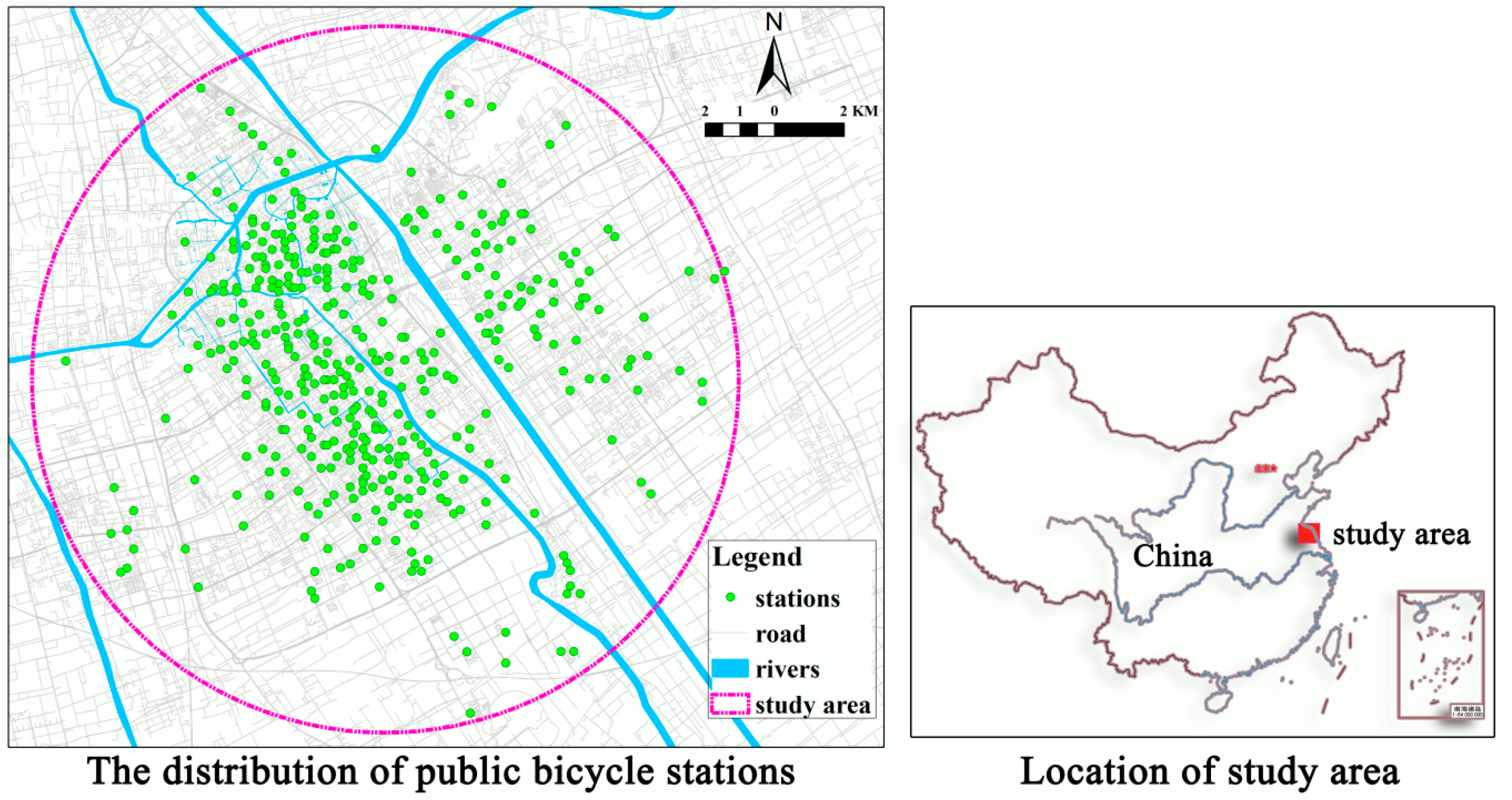

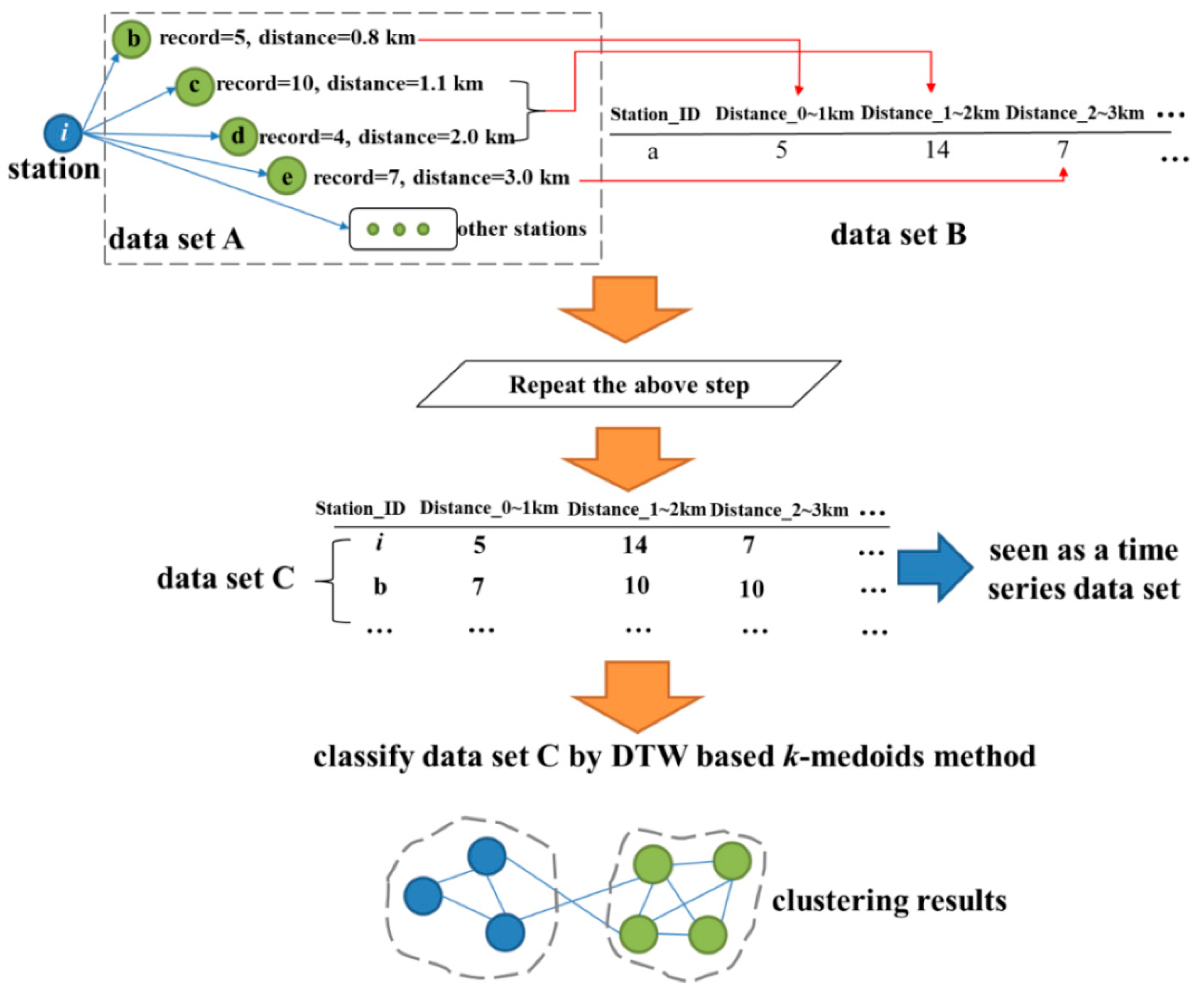
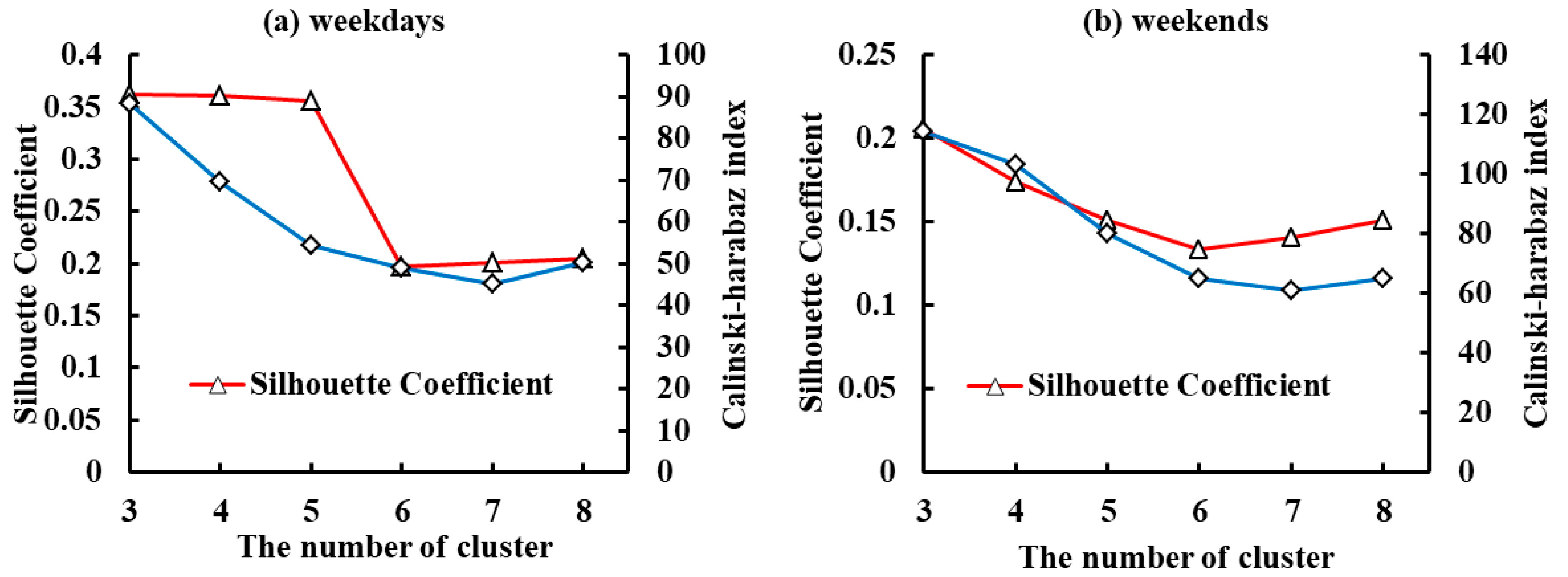

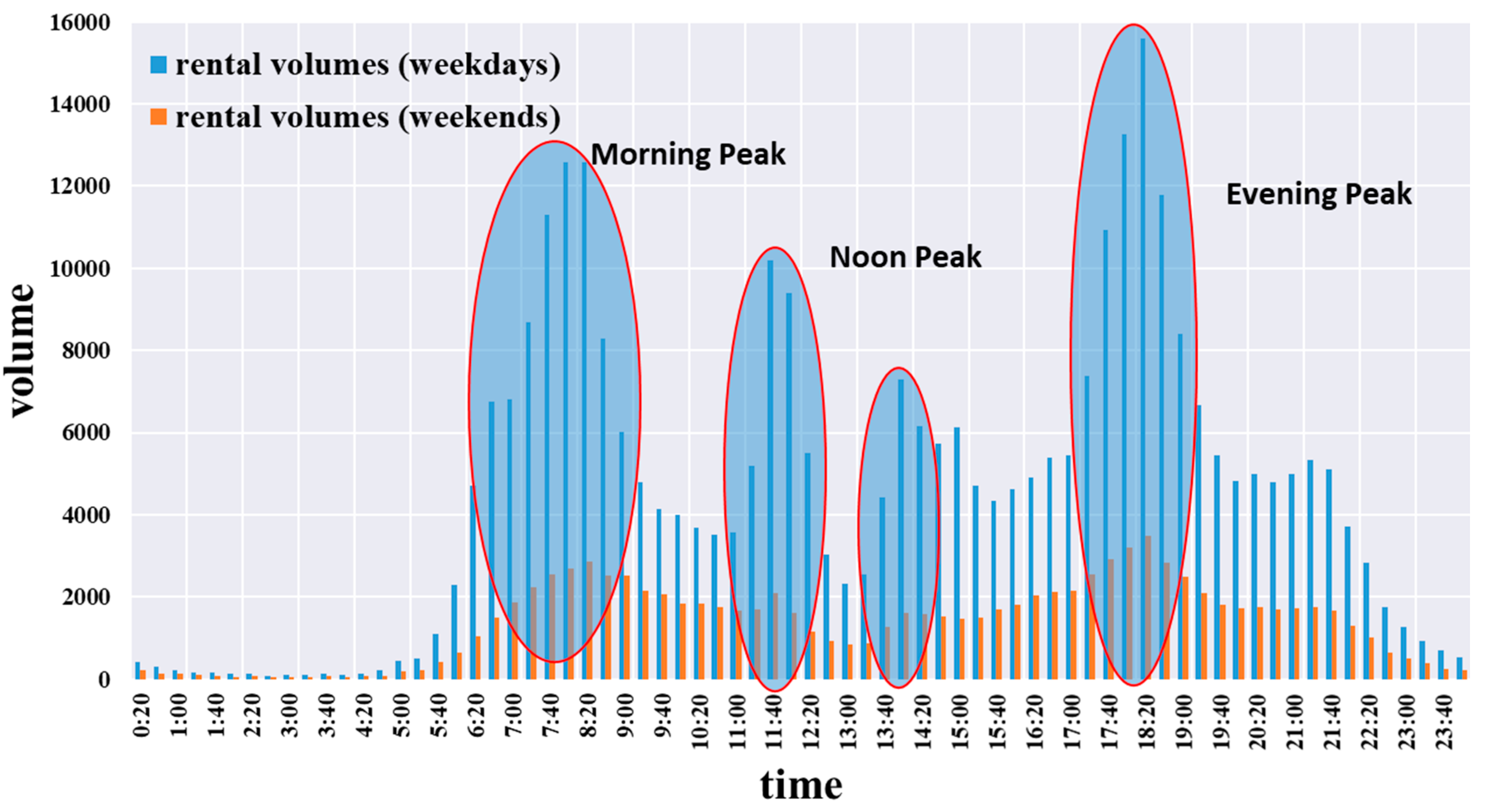
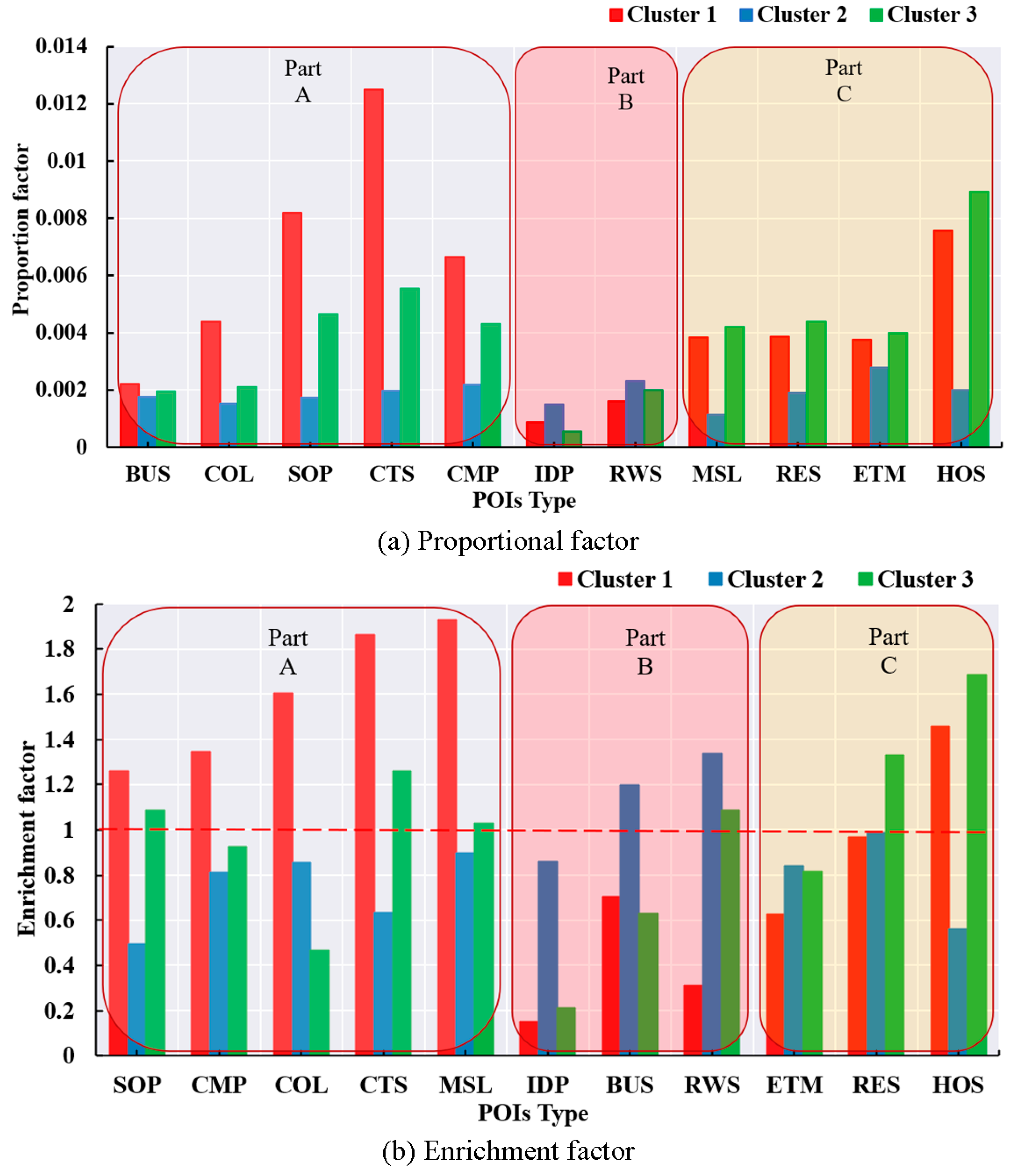
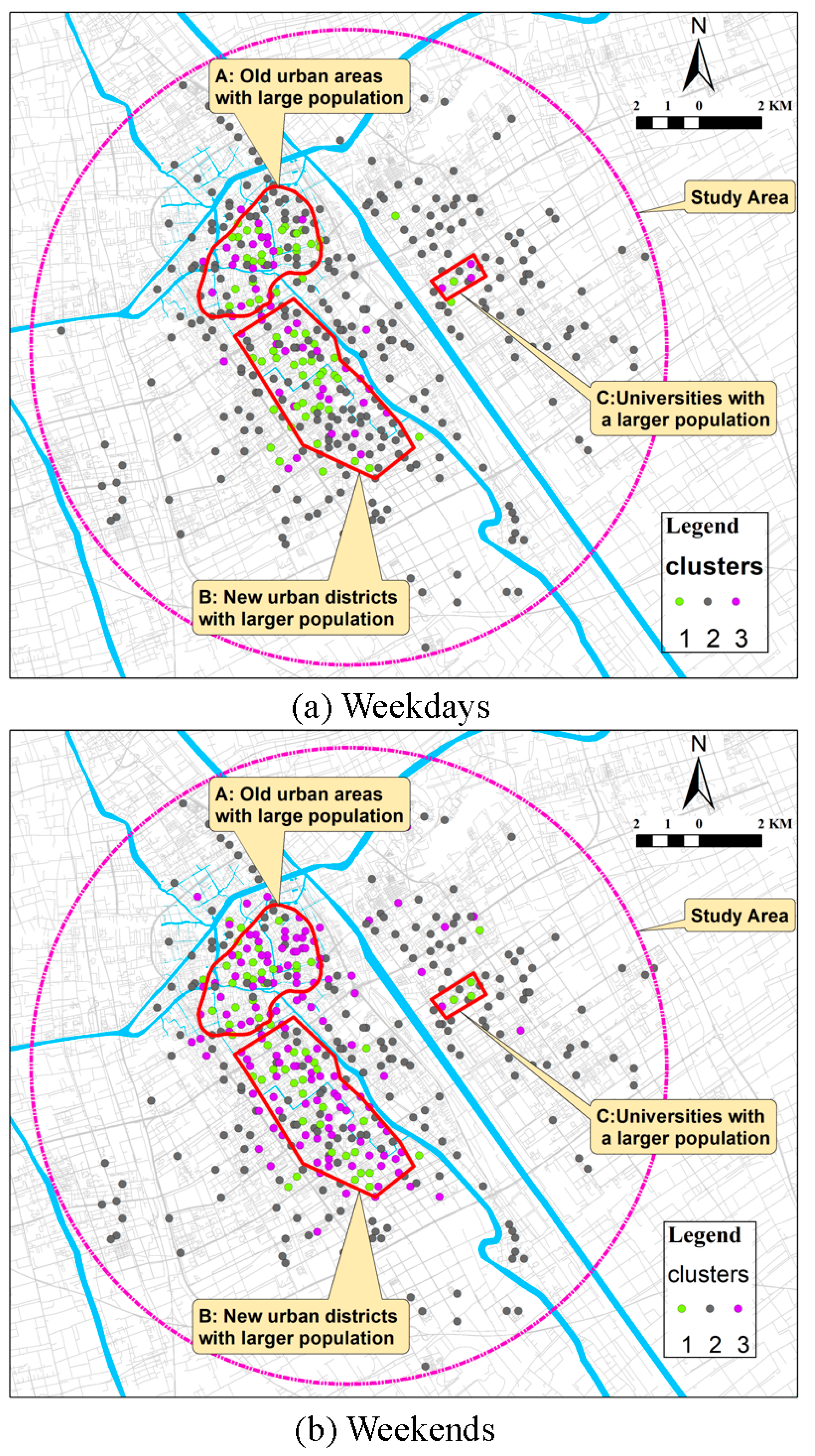
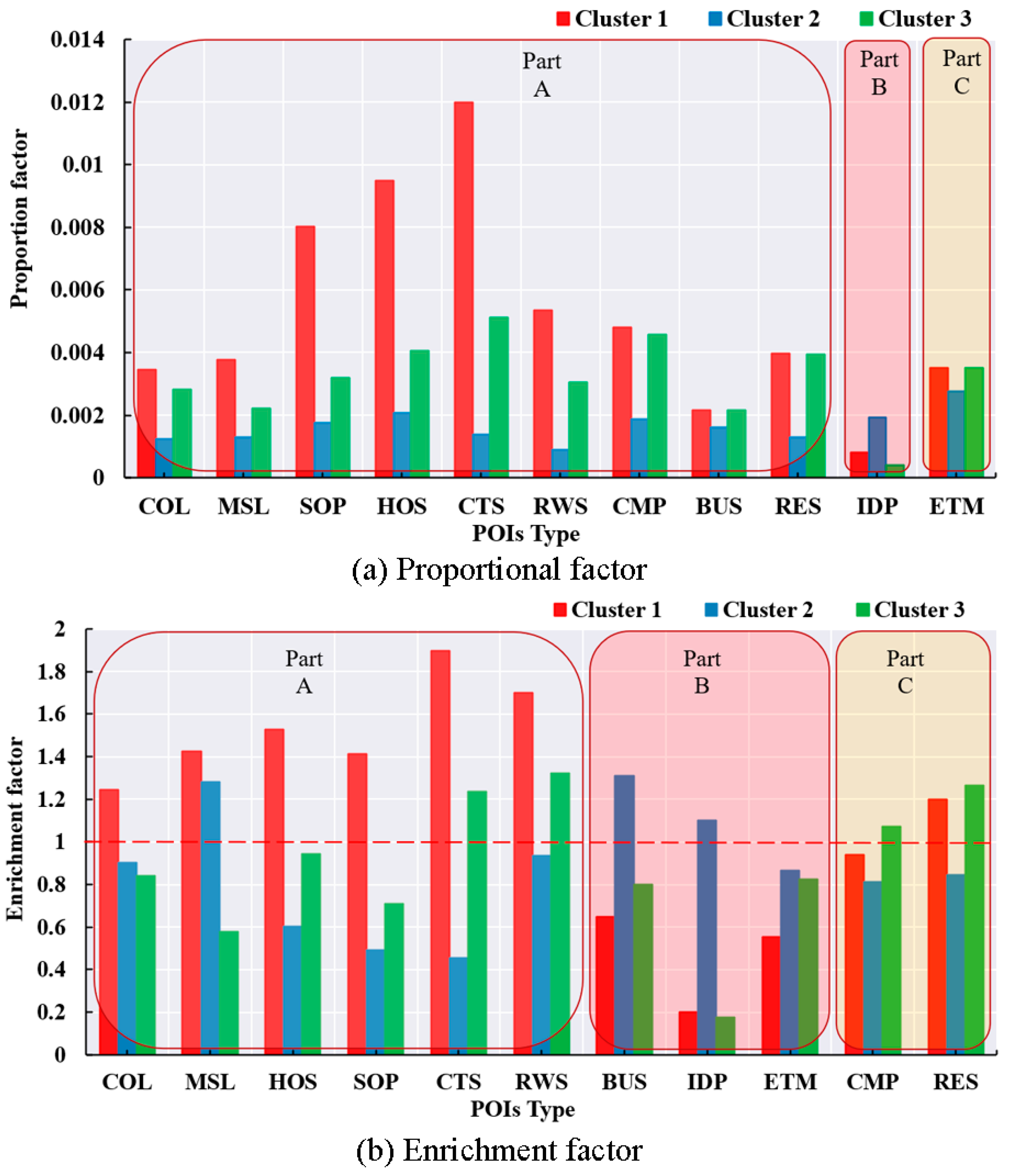

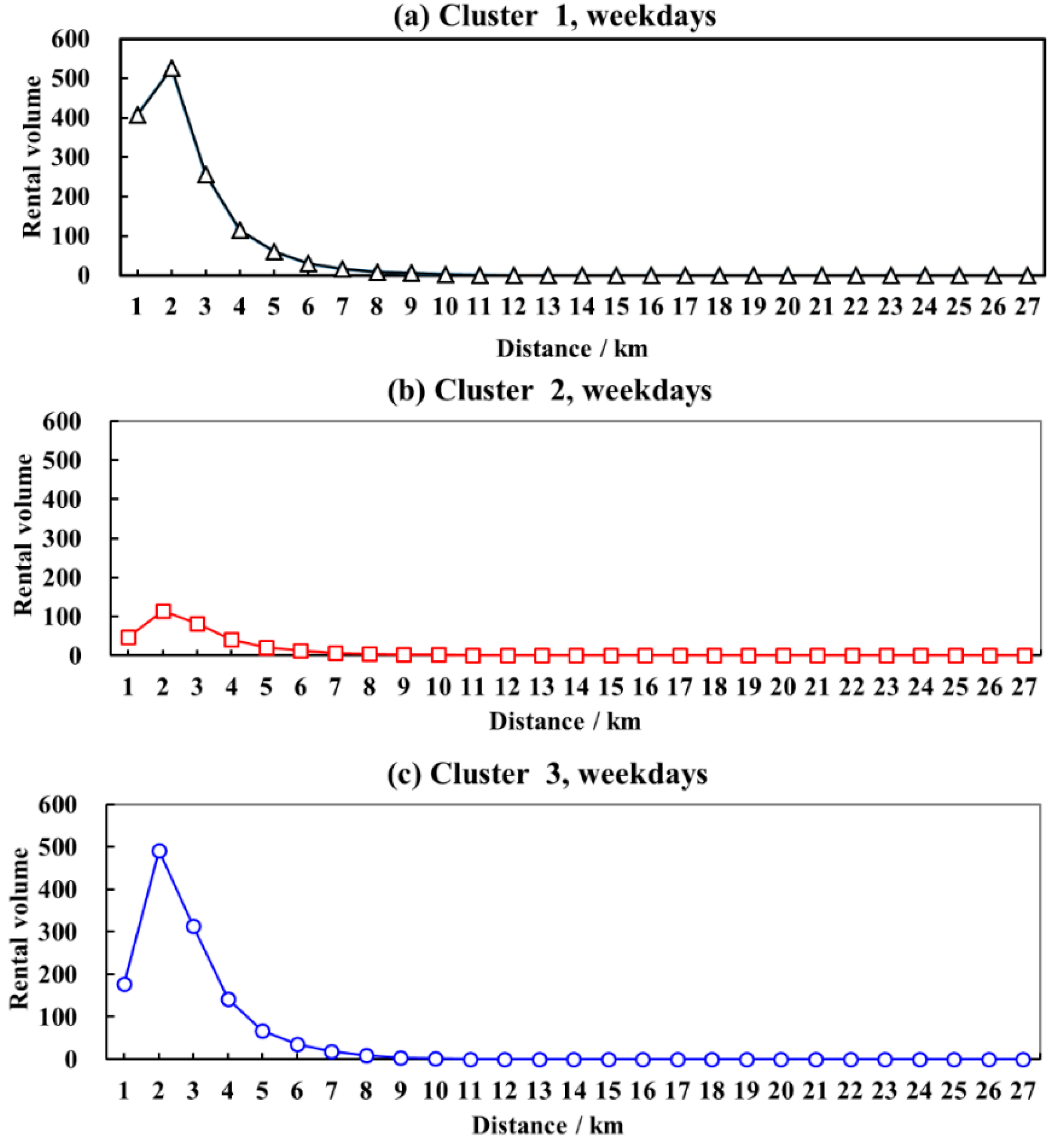
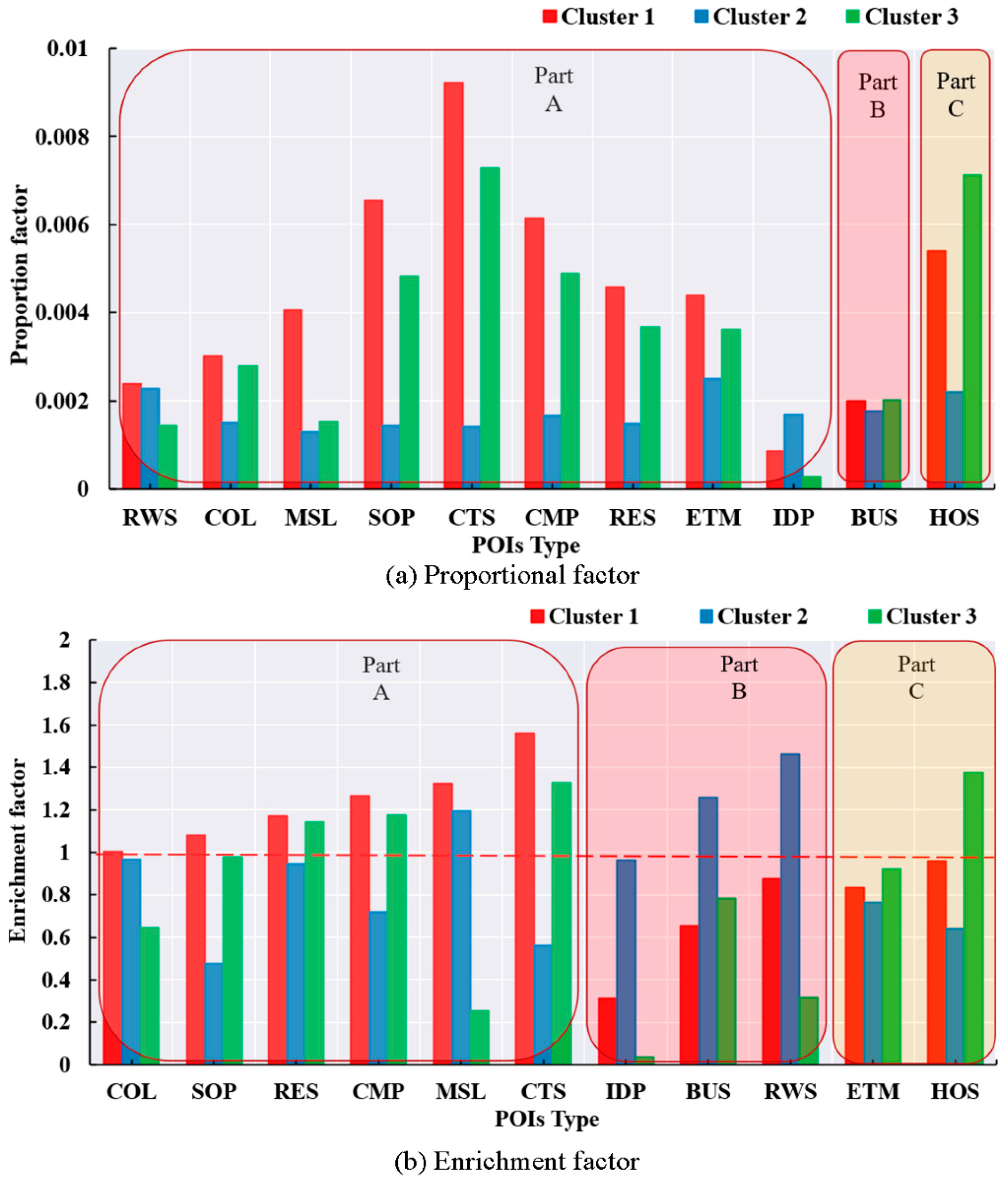

| POI Type | Abbreviation | POI Category Contents |
|---|---|---|
| 1. College | COL | Universities and vocational schools |
| 2. Middle school | MSL | Middle schools |
| 3. Bus station | BUS | Bus stations |
| 4. Major hospital | HOS | Specialized hospitals, tertiary first-class hospitals, comprehensive hospitals, and so on |
| 5. Major shopping | SOP | Shopping malls, comprehensive markets, typical commercial streets, and so on |
| 6. Catering service | CTS | Coffee shops, Kentucky Fried Chicken, McDonald’s restaurants, bars/pubs, and so on |
| 7. Industrial park | IDP | Industrial parks |
| 8. Long-distance transit station | RWS | Railway stations, long-distance bus stations |
| 9. Residence | RES | Dormitories, residential areas, and so on |
| 10. Entertainment venue | ETM | Tourist attractions, parks, and so on |
© 2020 by the authors. Licensee MDPI, Basel, Switzerland. This article is an open access article distributed under the terms and conditions of the Creative Commons Attribution (CC BY) license (http://creativecommons.org/licenses/by/4.0/).
Share and Cite
Gao, Z.; Wei, S.; Wang, L.; Fan, S. Exploring the Spatial-Temporal Characteristics of Traditional Public Bicycle Use in Yancheng, China: A Perspective of Time Series Cluster of Stations. Sustainability 2020, 12, 6370. https://doi.org/10.3390/su12166370
Gao Z, Wei S, Wang L, Fan S. Exploring the Spatial-Temporal Characteristics of Traditional Public Bicycle Use in Yancheng, China: A Perspective of Time Series Cluster of Stations. Sustainability. 2020; 12(16):6370. https://doi.org/10.3390/su12166370
Chicago/Turabian StyleGao, Zhan, Sheng Wei, Lei Wang, and Sijia Fan. 2020. "Exploring the Spatial-Temporal Characteristics of Traditional Public Bicycle Use in Yancheng, China: A Perspective of Time Series Cluster of Stations" Sustainability 12, no. 16: 6370. https://doi.org/10.3390/su12166370
APA StyleGao, Z., Wei, S., Wang, L., & Fan, S. (2020). Exploring the Spatial-Temporal Characteristics of Traditional Public Bicycle Use in Yancheng, China: A Perspective of Time Series Cluster of Stations. Sustainability, 12(16), 6370. https://doi.org/10.3390/su12166370




